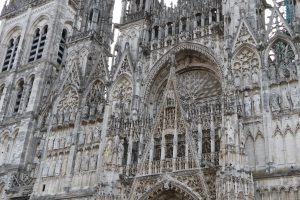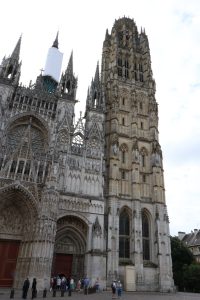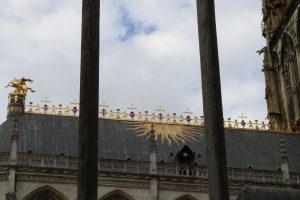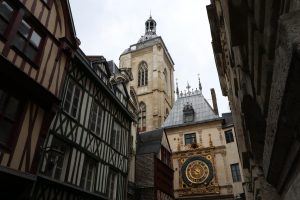In Rouen we are berthed close to the city centre so we are split into a number of walking groups and with ear pieces in place we head up the steps and into the city. Rouen is the limit of the tidal flow – further west the Seine is canalised to allow larger boats to reach this far along the river towards Paris. It is a major centre with huge grain silos in the port area and a little further westwards there are two huge oil refineries which are supplied by sea – at least one still has the capacity for despatching refined products by rail, although there is also evidence of river tankers which we passed on the way here as another means of distribution.
Out first stop in Rouen is the enormous cathedral which has one of the highest spires in Europe and the highest in France. Apparently having the highest spire at one point was a competitive sport in Europe and the others slightly outstripped Rouen as time passed. Mirrored in many ways by the competitive building of Towers in the 1960s which have been noted in most European capital cities!
The cathedral’s entrance is impossible to fit into the camera’s viewfinder for a single shot as one cannot stand far enough back. There is an incredible amount of carved detail all over the face of stonework which shows that the work involved was enormous.
It is not only the front of the cathedral or the interior which is decorated but also there are carved figures on the roof although I have struggled to find any information about them. Indeed finding photographs is difficult. So I thought I would include one.
We then progress through the pedestrianised area. The centre of the town is marked a grand clock which tells the time – but in its own way. The Gros Horloge dates back to 1389. The hour hand revolves once in 24 hours – there are 24 rays to the sun. Moon phases are in the upper part of the dial. Week days are at the base of the dial in allegorical form (Diane/Moon – Monday, Mars – Tuesday, Mercury – Wednesday, Jupiter – Thursday, Venus – Friday, Saturn – Saturday, Apollo – Sunday).
The supporting archway pays tribute to the original source of wealth in the area – sheep.
The final stop on the route was until the 1960’s the local market and the area was the location where Joan of Arc was burned at the stake. A new development encompasses the remaining market stalls plus a modern church as a memorial to France’s revolutionary heroine. It is also a reminder that for a long time western France and England were ruled by William the Conqueror and his successors.
This evening there is a quiz with 20 questions and a total of 23 points. Our group of 4 did well getting 22 out of 23. We could not recall the name of a particular Clint Eastwood film – “Unforgiven”.



